Guide To Affordable Green Cleaning for Every Home |
Eco-friendly Cleaning
Living sustainably goes beyond just the food we eat or the products we use, It extends to our everyday cleaning routines. Green cleaning, also known as eco-friendly or sustainable cleaning, is an essential aspect of adopting a sustainable lifestyle. In this comprehensive guide, We’ll explore the principles of green cleaning, provide practical examples, share relevant statistics, and discuss the challenges and rewards of embracing this environmentally conscious approach to keeping our living spaces clean.
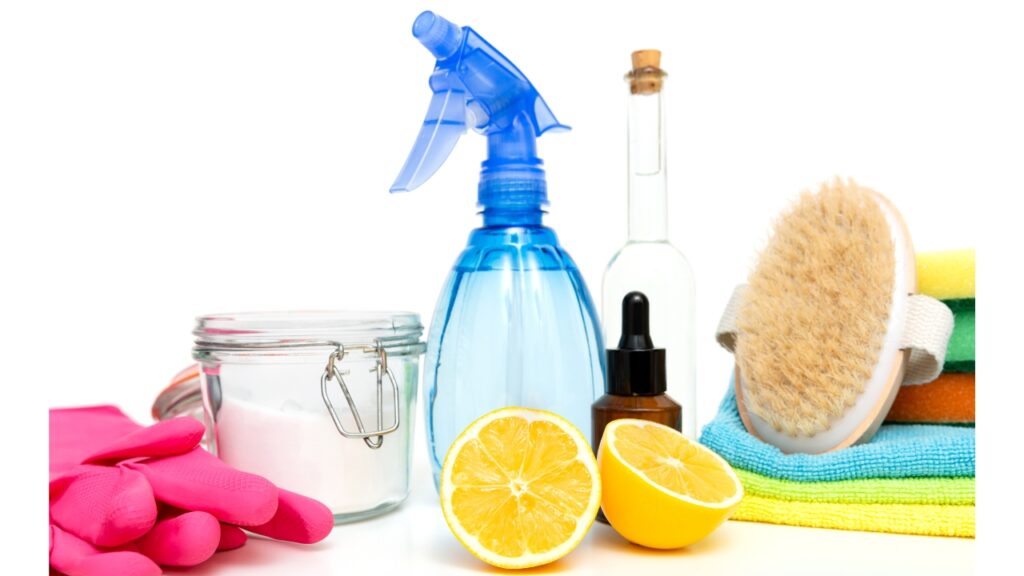
Table of Contents
What is Green/Eco Friendly Cleaning?
Eco Friendly Cleaning or Green cleaning involves using cleaning methods and products that are designed to be environmentally friendly. This means minimizing the use of harsh chemicals that can harm the environment, as well as our health, and opting for sustainable alternatives.
The Importance of Green Cleaning:
Reducing Environmental Impact:
Reducing environmental impact in the context of green cleaning involves adopting practices and using products that minimize harm to the environment throughout the cleaning process. Traditional cleaning methods often involve the use of harsh chemicals and disposable materials that can contribute to pollution, resource depletion, and overall environmental degradation. Here’s a closer look at how green cleaning reduces environmental impact:
- Non-Toxic Ingredients:
- Problem: Conventional cleaning products often contain harmful chemicals such as ammonia, bleach, and phthalates. When these chemicals are used, they can be released into the air and water, contributing to air pollution and water contamination.
- Solution: Green cleaning promotes the use of non-toxic, natural ingredients like vinegar, baking soda, and essential oils. These ingredients are safer for both the environment and human health.
2. Biodegradability:
- Problem: Many commercial cleaning products contain synthetic chemicals that do not readily break down in the environment. These non-biodegradable substances can accumulate in soil and water, posing a long-term threat to ecosystems.
- Solution: Green cleaning products are designed to be biodegradable, meaning they can break down into natural substances over time. This reduces the risk of environmental pollution and minimizes the impact on ecosystems.
3. Reduced Packaging Waste:
- Problem: Conventional cleaning products often come in single-use plastic containers, contributing to the global plastic waste crisis. Improper disposal of these containers can lead to pollution of land and water bodies.
- Solution: Green cleaning encourages the use of products with minimal packaging or packaging made from recycled and recyclable materials. Additionally, individuals can opt for bulk purchases to reduce overall packaging waste.
4. Energy Efficiency:
- Problem: Manufacturing and transporting conventional cleaning products often involve significant energy consumption, contributing to greenhouse gas emissions.
- Solution: Green cleaning encourages energy-efficient practices, such as using concentrated cleaning solutions that require less energy in production and transportation. Additionally, homemade cleaning solutions reduce the need for energy-intensive manufacturing processes.
5. Water Conservation:
- Problem: Some traditional cleaning methods involve excessive water usage, contributing to water scarcity and increasing the energy required for water treatment.
- Solution: Green cleaning emphasizes water conservation by promoting efficient cleaning practices, such as using microfiber cloths that require less water and opting for low-flow or aerated faucets.
6. Reduced Air Pollution:
- Problem: Certain cleaning products release volatile organic compounds (VOCs) into the air, contributing to indoor and outdoor air pollution.
- Solution: Green cleaning focuses on using products with low or no VOC content, improving indoor air quality. This, in turn, contributes to a healthier environment and reduces the overall burden on air quality.
By addressing these aspects, individuals can actively contribute to reducing their environmental impact through green cleaning practices. It’s not just about cleaning surfaces; it’s about making choices that align with sustainability principles, creating a healthier living space for both people and the planet.
Health Benefits:
The health benefits of green cleaning are significant and play a crucial role in promoting overall well-being. Unlike conventional cleaning products that often contain harsh chemicals and toxins, green cleaning focuses on using natural and environmentally friendly alternatives. Here are some key health benefits associated with adopting a green cleaning approach:
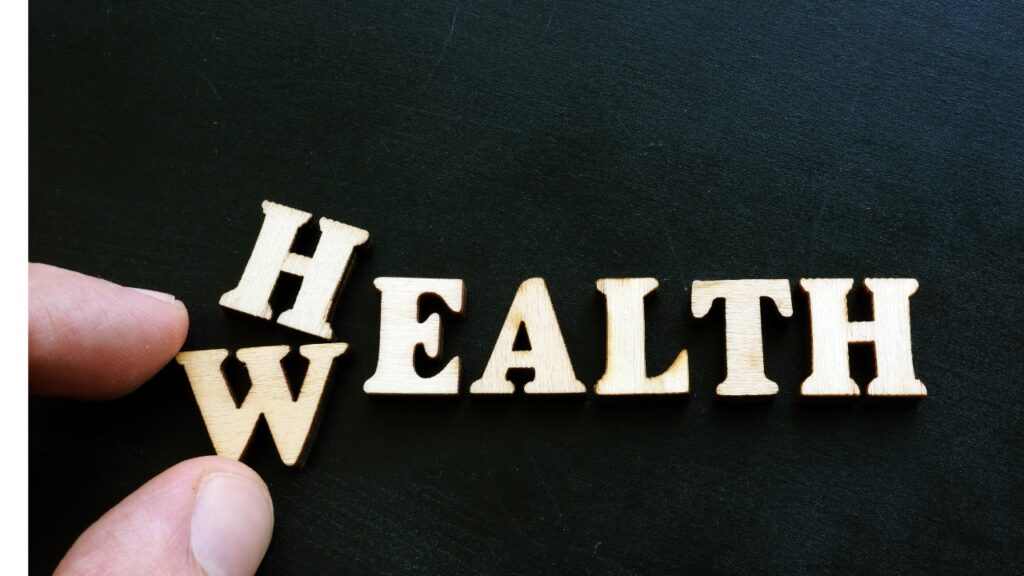
1. Reduced Exposure to Harmful Chemicals:
- Conventional cleaning products often contain harsh chemicals such as ammonia, chlorine, and synthetic fragrances. Prolonged exposure to these chemicals can lead to respiratory issues, skin irritations, and other health problems. Green cleaning, on the other hand, relies on natural ingredients like vinegar, baking soda, and essential oils, minimizing exposure to harmful substances.
2. Improved Indoor Air Quality:
- Many traditional cleaning products release volatile organic compounds (VOCs) into the air, contributing to indoor air pollution. VOCs can cause a range of health issues, including headaches, dizziness, and respiratory irritation. Green cleaning helps improve indoor air quality by avoiding or significantly reducing the use of these harmful compounds.
3. Allergy and Asthma Relief:
- The chemicals found in some conventional cleaners can exacerbate allergies and asthma symptoms. Green cleaning products are typically hypoallergenic and do not contain common allergens. Using natural alternatives can provide relief to individuals with respiratory conditions, making the indoor environment more comfortable.
4. Safer for Children and Pets:
- Children and pets are often more vulnerable to the effects of harsh chemicals due to their smaller size and proximity to surfaces. Green cleaning products are generally safer for use around children and pets, reducing the risk of accidental exposure to toxic substances.
5. Prevention of Antibiotic Resistance:
- Some antibacterial agents found in conventional cleaners contribute to the development of antibiotic resistance in bacteria. Green cleaning promotes the use of natural antibacterial ingredients like tea tree oil and vinegar, which do not contribute to the growing problem of antibiotic resistance.
6. Skin-Friendly Solutions:
- Harsh chemicals in conventional cleaners can cause skin irritations and allergic reactions. Green cleaning solutions, often made from gentle ingredients, are less likely to cause skin problems, promoting healthier skin for those who come into contact with cleaned surfaces.
7. Long-Term Health Benefits:
- Consistent use of green cleaning practices can contribute to long-term health benefits. By minimizing exposure to harmful chemicals and toxins, individuals may experience fewer health issues over time, leading to an improved quality of life.
Avoiding Harmful Chemicals:
Green cleaning revolves around the core principle of minimizing harm to the environment and our health. One of the fundamental aspects of this eco-friendly approach is steering clear of harmful chemicals commonly found in conventional cleaning products. In this exploration, we delve into why avoiding these chemicals is crucial and provide practical tips on adopting a cleaner and greener alternative.

Identifying Harmful Chemicals
- Ammonia:
- Found in glass cleaners and polishing agents, ammonia fumes can irritate the eyes, nose, and throat.
- Bleach:
- A potent disinfectant but a harsh irritant, bleach can cause respiratory problems and skin sensitivities.
- Phthalates:
- Often found in fragranced cleaning products, phthalates are known endocrine disruptors linked to reproductive and developmental issues.
- Triclosan:
- Commonly used in antibacterial cleaners, triclosan has raised concerns about its contribution to antibiotic resistance and potential environmental harm.
Practical Tips for Avoiding Harmful Chemicals in Green Cleaning:
- Read Labels:
- Familiarize yourself with the ingredients in cleaning products. Opt for those with clear, transparent labels that disclose their components.
- Choose Green Brands:
- Look for cleaning brands that specialize in eco-friendly and non-toxic products. Many companies now offer a range of green alternatives.
- DIY Cleaning Solutions:
- Create your own cleaning solutions using natural ingredients like vinegar, baking soda, lemon, and essential oils. These alternatives are effective and gentle.
- Ventilate Indoor Spaces:
- When using any cleaning product, ensure proper ventilation to reduce indoor air pollution. Open windows and doors to allow fresh air circulation.
- Avoid Single-Use Products:
- Opt for reusable cleaning tools and cloths instead of disposable wipes, reducing the environmental impact of your cleaning routine.
Avoiding harmful chemicals in cleaning is at the heart of green cleaning. By making conscious choices in the products we use and embracing natural alternatives, we not only protect the environment but also prioritize the health and well-being of ourselves and our communities. It’s a step towards a cleaner, greener, and more sustainable future, One cleaning solution at a time.
Practical Examples of Green Cleaning:
1. All-Purpose Cleaner:
An all-purpose cleaner is a cleaning solution formulated to handle different surfaces and types of grime. It typically replaces the need for multiple specialized cleaners, making it a convenient and cost-effective choice. Traditional all-purpose cleaners often contain chemicals like ammonia, chlorine, and various synthetic fragrances, contributing to indoor air pollution and negatively impacting the environment.
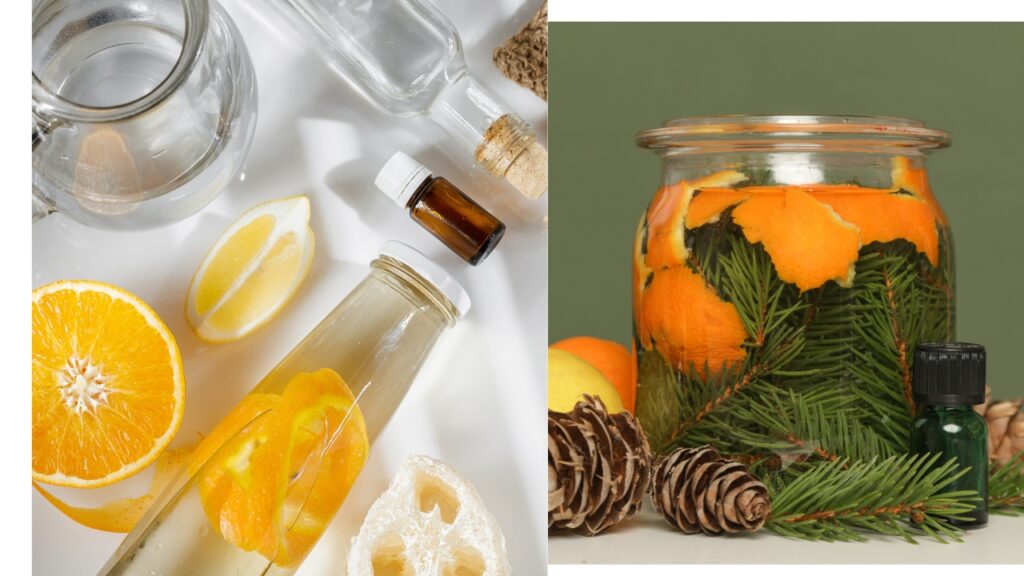
How to Make a Simple Green All Purpose Cleaner:
Creating your own green all-purpose cleaner is surprisingly easy and requires minimal ingredients. Here’s a basic recipe:
Ingredients:
- 1 cup distilled white vinegar
- 1 cup water
- 20-30 drops of essential oil (e.g., tea tree, lavender, or lemon for added fragrance and antibacterial properties)
Instructions:
- Mix the Ingredients: Combine the white vinegar and water in a spray bottle.
- Add Essential Oils: Add 20-30 drops of your chosen essential oil to the mixture.
- Shake Well: Close the spray bottle and shake well to ensure thorough mixing.
2. Homemade Scrub:
A homemade scrub is a cleaning mixture created by combining basic household ingredients to form a paste or abrasive substance. This mixture is designed to tackle tough stains, soap scum, and grime on various surfaces, particularly in kitchens and bathrooms. The key advantage of a homemade scrub is its minimal environmental impact compared to commercial cleaning products.
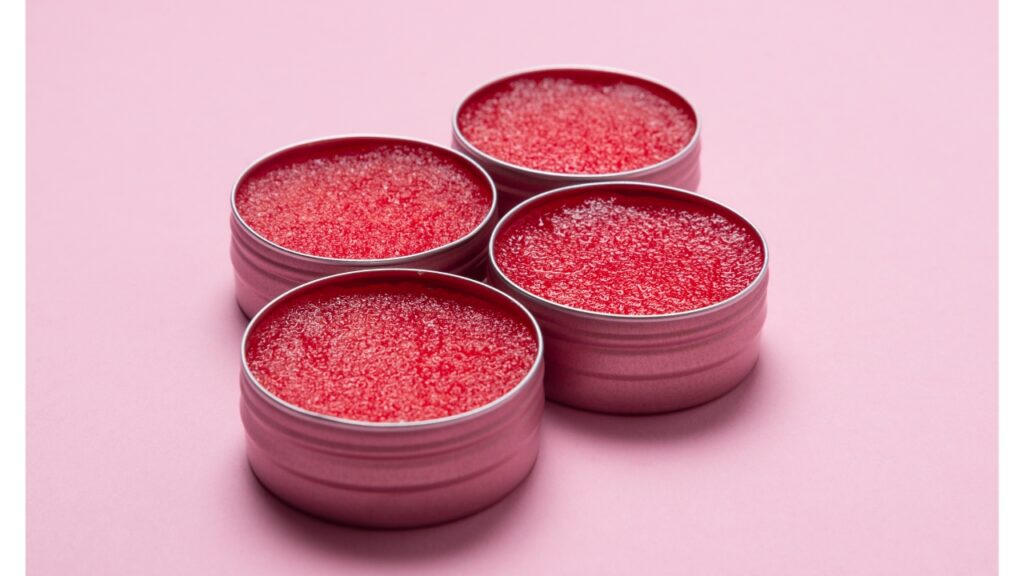
How to Make a Basic Homemade Scrub:
Creating a basic homemade scrub is a straightforward process, and you only need a couple of common household items:
Ingredients:
- Baking soda
- Water
Instructions:
- Mixing the Ingredients:
- In a small bowl, combine baking soda with a small amount of water. The goal is to create a thick paste.
- Consistency Check:
- Adjust the ratio of baking soda to water until you achieve a consistency similar to commercial abrasive cleaners.
- Application:
- Apply the homemade scrub directly to the surface you want to clean. Use a sponge, brush, or cloth to scrub away stains and grime.
- Rinsing:
- Rinse the surface thoroughly with water to remove the scrub residue.
Feel free to experiment with different ingredients and ratios to find the perfect homemade scrub formula that suits your cleaning needs. The beauty of green cleaning lies in its adaptability and the satisfaction of knowing that you’re making a positive impact on both your home and the planet.
3. Natural Air Fresheners:
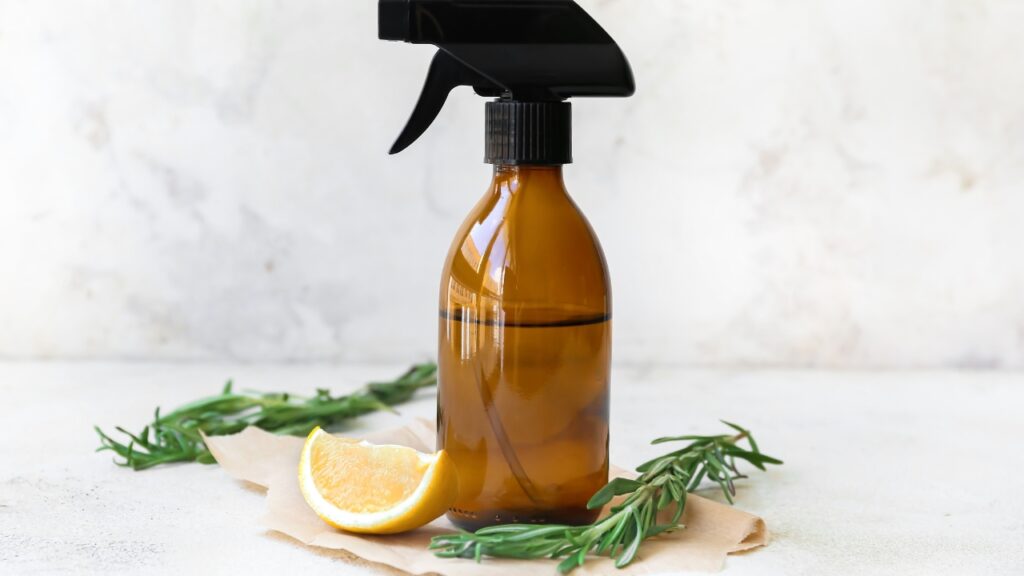
Creating a fresh and inviting atmosphere in our living spaces is an essential aspect of maintaining a comfortable home. However, the conventional air fresheners available in the market often contain synthetic fragrances and harmful chemicals that can contribute to indoor air pollution. In the spirit of green cleaning and sustainable living, turning to natural air fresheners offers a healthier and environmentally conscious alternative.
The Problem with Conventional Air Fresheners:
Conventional air fresheners typically come in the form of sprays, plug-ins, or solid products. While they promise to eliminate odors and create a pleasant ambiance, they often do so at the expense of introducing potentially harmful substances into the air we breathe. Common issues with conventional air fresheners include:
- Synthetic Fragrances: Many air fresheners use synthetic fragrances that can release volatile organic compounds (VOCs) into the air, contributing to indoor air pollution.
- Chemical Additives: Conventional air fresheners may contain chemicals such as phthalates, formaldehyde, and benzene, which have been associated with respiratory issues and other health concerns.
- Environmental Impact: The production and disposal of traditional air fresheners can have negative environmental consequences, contributing to pollution and waste.
Natural Air Fresheners: A Green Cleaning Solution
1. Citrus Peels:
- Citrus peels, such as those from lemons, oranges, or grapefruits, can be placed in strategic locations to naturally release a refreshing scent. They also add a touch of natural decor to your space.
2. Essential Oil Diffusers:
- Utilizing essential oil diffusers is a popular and versatile way to introduce natural scents into your home. Essential oils like lavender, eucalyptus, or peppermint not only smell delightful but also offer potential health benefits.
3. Herb Bouquets:
- Bundles of fresh herbs, such as rosemary, mint, or basil, can be tied together and placed in vases or hung to release their pleasant aroma.
4. Baking Soda with Essential Oils:
- Baking soda is known for its odor-absorbing properties. Mix it with a few drops of your favorite essential oil and place it in an open container to neutralize odors.
5. Beeswax Candles:
- Opt for beeswax candles with natural scents instead of traditional candles made with paraffin wax, which can release harmful pollutants when burned.
4. Reusable Cleaning Cloths:
Traditional paper towels and disposable cleaning wipes contribute significantly to environmental degradation. The production of these single-use items involves cutting down trees, consuming water, and generating substantial amounts of waste. Moreover, the energy-intensive manufacturing process and transportation further contribute to carbon emissions. As these disposable items end up in landfills, they add to the growing environmental concerns.
In the quest for sustainable living, consider alternatives to traditional paper towels and cleaning wipes. Explore eco-friendly options like reusable cloth wipes, as discussed in this insightful blog post on zero-waste living at link. Make a conscious choice for a greener future!
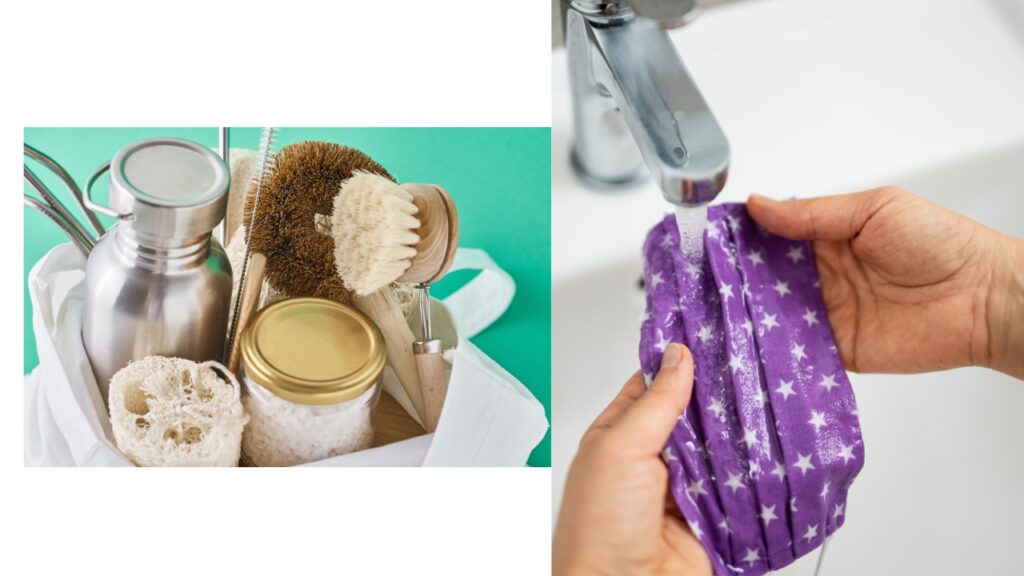
Practical Tips for Using Reusable Cleaning Cloths:
1. Designate Specific Cloths for Different Areas:
- Use color-coded cloths for different cleaning tasks to prevent cross-contamination. For instance, reserve one color for kitchen surfaces and another for bathroom cleaning.
2. Wash Regularly:
- To maintain hygiene and effectiveness, wash reusable cloths regularly. Most can be machine-washed, providing a convenient and eco-friendly cleaning solution.
3. Air Dry to Conserve Energy:
- Opt for air-drying your reusable cloths instead of using a dryer. This simple step further reduces the environmental impact associated with energy consumption.
- very small choice adds up to a significant impact. Reusable cleaning cloths not only contribute to waste reduction but also offer a financially savvy and versatile solution for maintaining a clean and eco-friendly living space. As we seek sustainable alternatives in our daily lives, the simple act of replacing disposable materials with reusable options demonstrates a commitment to a healthier planet, One cleaning cloth at a time.
Green Cleaning Statistics:
Ah, green cleaning! It’s a growing trend with both environmental and health benefits. Let’s dive into some interesting statistics:
Market Growth:
- The global household green cleaning products market is estimated to be worth USD 298.90 billion in 2023, and it’s projected to reach USD 494.96 billion by 2030 at a CAGR of 7.45%. This shows a steadily increasing demand for eco-friendly cleaning solutions.
- 40% increase in demand for green cleaning products and solutions by clients of professional cleaning services in the past 5 years.
Consumer Awareness and Interest:
- 26% of respondents in a Nielsen Global Home-Care Survey said that purchasing natural cleaning products was important to them.
- 24% said that purchasing cleaning products with eco-friendly packaging was important to them. This indicates growing awareness of the potential environmental impact of conventional cleaning products.
Environmental Impact:
- The cleaning industry in the US alone consumes 6 billion pounds of cleaning chemicals annually, some with known health and environmental risks.
- 4.5 billion pounds of sanitary paper products are consumed each year, requiring the cutting of approximately 25 million trees. Green cleaning aims to reduce these impacts.
Other Points of Interest:
- Green cleaning often involves using microfiber cloths instead of paper towels, further reducing resource consumption.
- Many DIY green cleaning recipes use readily available ingredients like vinegar, baking soda, and lemon juice, making them affordable and accessible.
Additional Resources:
- The Cleaning Industry’s Path from Green Cleaning to Sustainability: https://toolsense.io/sustainability/sustainability-in-the-cleaning-industry/
- Green Cleaning Product Statistics: https://kitchenerclean.com/services
Challenges of Green Cleaning:
1. Availability of Products:
- Finding effective green cleaning products may be challenging in some areas. However, making your own can be a viable and cost-effective solution.
2. Changing Habits:
- Transitioning from conventional to green cleaning may require a mindset shift. It’s about breaking the habit of reaching for chemical-laden cleaners.
3. Cost Considerations:
- Some sustainable cleaning products can be more expensive upfront. However, many DIY alternatives are cost-effective in the long run.
The Emotional Impact:
Making the switch to green cleaning can evoke various emotions:
1. Empowerment:
- Individuals often feel empowered knowing they are making choices that positively impact both their health and the environment.
2. Connection to Nature:
- Green cleaning often involves using natural elements, fostering a deeper connection to the environment.
3. Satisfaction:
- There’s a sense of satisfaction in creating your own cleaning solutions and reducing dependence on commercial, chemical-laden products.
Conclusion:
“Embracing green cleaning is a tangible and effective way to contribute to a more sustainable lifestyle. Explore our blog post on sustainable living https://wecareearth.com/ to discover simple practices and homemade alternatives that reduce environmental impact while creating healthier living spaces. Despite challenges, the emotional rewards of feeling empowered and connected to nature make the transition to green cleaning a fulfilling journey toward a more sustainable and conscious way of living.”
